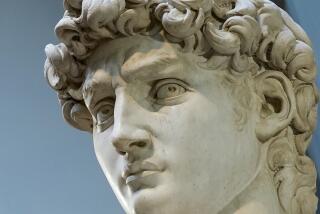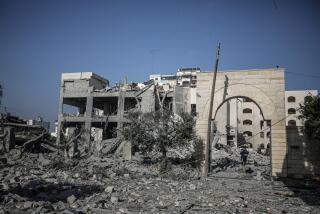In Italy, History Depletes Itself
POMPEII, Italy — Guido Barone doesn’t make the rules here, so he can only wince at the latest assault on this ancient Roman city--by an army of backpacks.
Squeezing into Pompeii’s fragile ruins on the backs of tourists, they scrape precious wall paintings as their bearers pivot recklessly in overcrowded spaces.
“You cannot force people to leave those things outside,” Barone says in dismay amid a traffic jam in the House of the Vettii.
A part-time comic actor, he finds little amusement guiding visitors through Pompeii, the city buried by the fiery eruption of Mt. Vesuvius in AD 79 and dug up over the last 2 1/2 centuries. He has worked here 26 years, long enough to see rain, dust, sunlight, vandals and weeds erase much of what Vesuvius had preserved intact.
The backpacks, which arrive each day by the thousands, are not just a new threat to the world’s oldest archeological dig. They are a measure of Italians’ booming interest in their cultural wealth--a fascination the country’s leaders are trying to cultivate in order to save the most battered treasures.
Their proposals are radical for Italy. They include private sponsorship for monuments such as Pompeii, an idea that spawns visions of Disney-like theme parks with Roman togas and ads for Fiat. A debate pitting American-style capitalism against traditional Italian state custody is just starting, but there’s an urgency to it.
According to the New York-based World Monuments Fund, no other nation has such a trove of endangered churches, castles, palaces, museums, ancient forums and archeological unearthings. And few other nations are experiencing such a rush by their people to see what’s still standing.
Unfortunately, says Antonio Paolucci, the artistic superintendent of Florence, “the erosion of our cultural patrimony is happening much faster than the growth in our political awareness” of the loss.
Italy’s dubious blessing is a wealth too vast for the state to protect. The government lists 57,000 “major” monuments spread among every city and the smallest of towns.
In a nation that resembles a sprawling outdoor museum, it’s small wonder that an average of 96 art objects are reported stolen from church or state custody every day.
In the last four years, Mafia bombs have damaged the Uffizi Gallery in Florence and two art-rich churches in Rome. Fires have swept through La Fenice, the 18th century opera house in Venice, and the chapel that housed the Shroud of Turin. Faulty restoration has brought down the roof of the cathedral in Noto, the jewel of Sicilian Baroque architecture.
If all that were not enough, earthquakes have been shaking hill towns across Umbria and the Marches for weeks this autumn, toppling medieval bell towers and cracking scores of early Renaissance frescoes, including some in the badly damaged Basilica of St. Francis of Assisi.
A String of Reformers at the Culture Ministry
The same four years have brought a string of reformers to Italy’s Ministry of Culture.
They have revalued what is being lost and coaxed the Treasury to spend more for preservation. Museums closed for years are being reopened and visiting hours extended to make antiquity more accessible--and potentially profitable.
Italians are responding en masse.
The 33 largest museums reported a 20% increase in visitors last summer. That does not count the smallish but exquisite Borghese Gallery, which has been filled to capacity since it reopened in June after 14 years of repairs. It still requires booking more than a week in advance.
Nor does it count Pompeii, which is drawing more than 2 million visitors this year, up from 1.3 million in 1993.
Many of the visitors are foreign, of course, but no one doubts that the renaissance is Italian.
Arguing that antiquity is “our petroleum,” independent preservation groups such as Archeoclub and ItaliaNostra have gained tens of thousands of members. Private funds to shore up public monuments are starting to flow from banks, elementary schools and other sponsors.
Italians are opening guidebooks and becoming tourists at home.
“Every stone tells a story,” marvels Antonio Durante, 57, a Roman venturing into the ancient Forum for only the second time. “These stories connect us to the great civilizations of our past.”
“All of a sudden, Italians realize they have a tremendous amount of treasures, which must be seen before it’s too late,” sociologist Franco Ferrarotti says. “Part of this is a quest for social status--going to a museum just to say you were there. But there is also a feeling that we can find national unity and identity--a badge of distinction in the world--only in terms of our artistic patrimony.”
Whether this grass-roots enthusiasm can be harnessed to save Italy’s monuments is about to be tested on Pompeii--the most visited, underfunded and threatened of them all.
Profit Motive Taboo for Postwar Parties
A novelty of the experiment is the profit motive--a taboo for the postwar Christian Democrats and Communists who shaped Italy’s statist cultural policies.
A law taking effect this month gives Pompeii autonomy from the bureaucracy in Rome, allowing the ruined city to keep all its tourist income and seek private investment.
Culture Minister Walter Veltroni, a former Communist, has warned Italian industrialists that Pompeii will “die a second death” unless they pitch in.
The new law permits the industrialists to finance restoration in Pompeii by “adopting” city blocks for up to three years in exchange for tax breaks and commercial rights to use any image on the premises.
If the remedy works, Veltroni says, it will be extended to other museums and monuments across Italy, breaking up a system of management notoriously inept, negligent, corrupt and user-unfriendly.
Pompeii has suffered the worst of all that.
For starters, there are few nearby hotels and no place to check valuables, which explains all the backpacks. The setup is confusing, with no maps or explanatory material. Visitors, who often outnumber the ghosts of Pompeii’s 15,000 ancient inhabitants, share six toilets and dodge packs of wild dogs; the adjacent modern city has no kennel.
Two-thirds of ancient Pompeii--110 of its 163 acres--have been unearthed. Tall weeds cover many blocks, and squatters plant vegetables on the unexcavated parts. All but 35 acres are closed to visitors--to protect the people from collapsing walls but also to help 150 guards protect the ruins from graffiti artists and souvenir hunters.
Pompeii still offers the most revealing look at everyday urban life in the ancient world.
For the $7 entry fee, a visitor can see temples, baths, the forum, an amphitheater, a brothel, private mansions and hundreds of simpler houses--many with their original mosaic floors and wall paintings. Archeologists have even preserved some Pompeians, down to their anguished dying expressions, in the form of eerie plaster body casts.
“It’s like being on a movie set,” says Marco Paccosi, a 36-year-old schoolteacher. “With a little bit of fantasizing, you can easily travel back to that time.”
Two Plaster Cadavers Decapitated at Pompeii
Life in today’s Pompeii often resembles a film noir.
One weekend last spring, someone entered a closed excavation site and decapitated two plaster cadavers. The field archeologist suspects vandals, but Pompeii’s superintendent, Pietro Giovanni Guzzo, says he took the Mafia-style gesture as a “warning” from one of his many enemies.
Guzzo’s predecessor, removed nearly three years ago, has been under investigation for excavations that were imaginary except in cost.
Guards once locked out tourists to protest Guzzo’s stricter regime; he demands that they show up on time and not sleep on the job.
The biggest problem is simply that too much of Pompeii has been dug up and not properly shielded from the elements. A walk through the ruins with a veteran guide like Barone is an exercise in imagining ancient treasures lost to modern neglect.
“Fifteen years ago this was a beautiful piece; every detail was absolutely clear,” the ponytailed Neapolitan recalls, pointing the tip of his tartan umbrella at a still-life painting now faded beyond recognition.
Turning to another blur in the same Vettii courtyard, he says: “We used to tell tourists, ‘If you want to know what kind of flowers they planted in their garden, look at this fresco.’ ”
Now the painted flowers are gone too.
Across the yard, in the adorably frescoed Room of the Cupids, Barone’s umbrella points at the ceiling, built of cheap reinforced concrete in the 1960s and already crumbling. A camera flash goes off, and more tourists muscle in. Two elderly guards, engrossed in discussion with each other, ignore the unruly crowd. A stray dog wanders in and curls up in the atrium.
Surveying the chaos, Barone ventures a prediction: “The next eruption of Vesuvius will save Pompeii!”
In his spacious office at the edge of the ruins, Guzzo lights his pipe and ponders his mission.
Pompeii’s superintendent has won worldwide applause from fellow archeologists, but he talks like a man under siege.
“The area [of Pompeii] now open to the public is half what was open in the 1950s,” the 53-year-old Roman says. “At this rate, by 2040, we’ll be reduced to half of that, and so on. . . . This is the death of Pompeii. Death will not come with one shock, as in an earthquake. But slowly and surely it will come--unless we do something to reverse the trend.”
His plan is to stop new excavations and pour resources into protecting and cataloging what has been dug up.
“We must stop the walls from crumbling, freeze the deterioration so we can hand this ancient city to our children,” Guzzo says. “That’s No. 1.”
A minimal once-over repair, he estimates, will cost $310 million and take 10 years.
Until now, his annual budget has been $3.1 million, one-third of what Pompeii earned in ticket sales and sent to Rome. The new, autonomous status will give Pompeii its full box- office take and maybe some extra income from better management, but it will not be nearly enough.
Can Pompeii raise the rest from private sponsors?
The answer is not clear, but Giovanni Losavio, vice president of ItaliaNostra, warns that it should not even try.
“Private adoption is a dangerous idea,” he argues. “It allows the state to flee its responsibility to take care of such treasures as Pompeii, whatever the cost.” Allowing images from Pompeii to be used commercially, he adds, “would somehow degrade those images.”
Fiat, the Italian auto maker, has voiced interest in “adopting” a block in Pompeii, but only if it sees a clear profit.
Many entrepreneurs wonder whether a Pompeian fresco in an ad logo is worth a multimillion-dollar investment--especially in the many blocks devoid of well-known images.
Debate on Letting Firms In On Tourism
There is debate on broadening the new law to let business-people profit from Pompeii tourism by taking over the blocks they restore and turning them into entertainment concessions, featuring the likes of Pompeian wine parties and mock slave auctions.
Veltroni, the culture minister, encouraged this kind of imaginative thinking last spring when he suggested using computers to make virtual reproductions of those haunting body casts and “create a kind of Jurassic Pompeii.”
Guzzo has joined the traditionalists in resisting such fun and games as premature.
“He would hate to see $100 million spent on a huge virtual Pompeii when the real Pompeii is falling apart,” says a foreigner who advises him.
Instead, the man struggling to save the ancient city has a more modest vision: a small visitors center where tourists entering the ruins could first get a helpful orientation from an archeologist--and check their backpacks.
(BEGIN TEXT OF INFOBOX / INFOGRAPHIC)
On the Endangered List
Of he 100 most endangered sites listed by the New York-based World Monuments Fund, Italy has nine, more than any other country.
Padua: Botanical gardens
Terra del Sole (Forli): Prison cells
Florence: Gardens
Tarquinia: Etruscan painted tomb
Rome: Neopitagorica Basillica
Valmontone: Palazzo Doria Pamphili
Anacona: Arch of Trajan
Pompeii: Ancient city
Puglia: Rupestrian churches
More to Read
Sign up for The Wild
We’ll help you find the best places to hike, bike and run, as well as the perfect silent spots for meditation and yoga.
You may occasionally receive promotional content from the Los Angeles Times.






